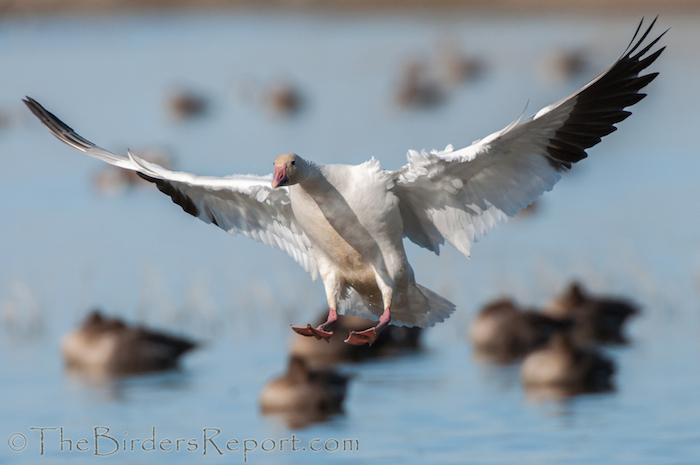My sister is not a bird watcher, but as she and her family drove back to the Bay Area after a Redding Thanksgiving we received her text: “What’s a big white bird with black wingtips?”
After confirming that they were near Willows and that there were many of the birds we told her “snow geese.”
Small wonder that the birds grabbed her attention. Every winter hundreds of thousands of them, in squealing tornadoes in the sky and squawking blankets over fields and ponds, inundate the Central Valley after nesting in the high arctic, mostly on the islands between Alaska and Greenland.
First the arctic story. The tilt of the North Pole toward the sun in the spring and summer creates a polar season in which the sun never sets, for up to as much as six months right at the North Pole. This abundance of daylight spurs plant growth, in which the grasses, sedges and algae lock great quantities of solar energy into their cells through photosynthesis. That energy is then available to feed geese and ducks and shorebirds by the millions. The birds eat either the plants or the hordes of invertebrates that eat the plants. It’s calorie-rich season, perfect for raising hungry offspring.
Snow geese typically lay a handful of eggs in a tundra tussock, usually in late May. The eggs hatch in some 23 days. Both parents then tend to the young, which follow them about, foraging on their own within a day of hatching. The goslings grow quickly, developing the strength to migrate south in the fall.
Spring snows can disrupt nesting, but mild weather has helped our Pacific flyway geese do very well over the last 10 years. Their numbers grew 53 percent from 2012 to 2013 alone, up to nearly 1.4 million.
In the Redding area, the geese and many arctic nesters find winter habitat at refuges like the Sacramento Wildlife Refuge in Willows. While some 95 percent of original Central Valley habitat has been paved, built upon or turned into farms, the refuges and unburned rice fields help compensate. Many farmers flood their fields through the winter, providing rich grazing and resting grounds that have helped geese thrive, perhaps to record numbers.
However, our drought limits the extent of field flooding both on farms and refuges. The birds, with less water available, squeeze into wherever the water is — a crowded condition that risks spreading disease. For the snow geese, nesting success may be countered with winter die-offs.
Still, in a time when so many species are in decline, the snow geese are flourishing. They remain a sight and sound that harkens to a wilder and inspiring time, and make it well worth a visit to the refuge or at least an open eye as you drive south on Interstate 5.
Note: The Wintu Audubon Society will be conducting a trip to the Sacramento Wildlife Refuge on Jan. 24. See our calendar page for all the information.
Send your bird questions to education@wintuaudubon.org


Comments are closed.